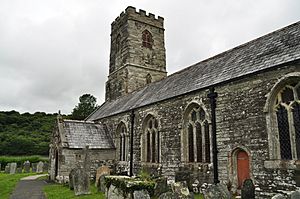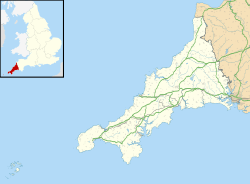St Winnow's Church, St Winnow facts for kids
Quick facts for kids St Winnow's Church, St Winnow |
|
|---|---|

St Winnow's Church, St Winnow
|
|
| 50°26′56″N 04°39′07″W / 50.44889°N 4.65194°W | |
| Location | St Winnow, Cornwall |
| Country | England |
| Denomination | Church of England |
| History | |
| Dedication | Saint Winnoc or Saint Winwaloe |
| Specifications | |
| Spire height | 95 feet (29 m) |
| Administration | |
| Parish | Saint Winnow with St Nectan’s Chapel |
| Deanery | Trigg Minor and Bodmin |
| Archdeaconry | Bodmin |
| Diocese | Truro |
| Province | Canterbury |
St Winnow's Church is a very old and important church located in the village of St Winnow, in Cornwall, England. It's a Grade I listed building, which means it's considered a special historical site. The church belongs to the Church of England.
Contents
History of the Church
Early Beginnings
Imagine a church standing here for over 1300 years! St Winnow's Church might have started as a small prayer place in the 600s. This early building was likely an "oratory" dedicated to Saint Winnoc.
Building Through the Centuries
A stone church was built in the 1100s. It probably had a cross shape, and you can still see parts of this original Norman stonework on the north side. In the 1200s, a part of the church called the transept arch was rebuilt. Around 1465, the south wall was taken down. A new south aisle, which is like a side section of the church, was then added.
Victorian Restoration
Between 1873 and 1874, the chancel, which is the area around the altar, was carefully restored. This work was done by an architect named John Dando Sedding. A new window made of Polyphant Stone was put in the chancel. This window has beautiful stained glass showing the crucifixion.
Two more new windows, also made of Polyphant Stone, were added to the main part of the church, called the nave. The chancel roof was made new with oak wood, and new seats were put in. The floor was laid with special patterned tiles. The nave also got new seats made of pitch-pine wood. The rood screen, a decorative screen that separates the chancel from the nave, was also fixed up. The church was reopened for services on April 11, 1874, by the Bishop of Exeter, Frederick Temple.
Inside the Church
Stained Glass and Screens
You can see amazing stained glass from around 1500 in the east windows of the chancel and the south aisle. The rood screen, which dates back to the 1500s, is carved with beautiful leaves and flowers. It was restored in 1907.
Font, Pulpit, and Bench Ends
The font, which is a large basin used for baptisms, is made of granite and dates from the 1300s. It's carved with angels holding shields. The pulpit, where sermons are given, is from around 1600 and has very detailed carvings. You can also find carved bench ends, which are the decorated ends of the wooden pews, from different times between 1485 and 1630.
Important Memorials
Inside the church, there is a monument for William Sawle, who passed away in 1651.
Church Connections
St Winnow's Church is part of a group of churches that work together. This group includes:
- Boconnoc Church
- St Mary the Virgin's Church, Braddock
- St Cyricius and St Julietta's Church, St Veep
- St Brevita’s Church, Lanlivery
- St Nectan’s Chapel, St Winnow
- St Bartholomew's Church, Lostwithiel
The Organ
The church has an organ with one manual (keyboard) and pedals. It has 9 "speaking stops," which are like different sets of pipes that make various sounds. You can find more details about this organ in the National Pipe Organ Register.
The Church Bells
Two Sets of Bells
St Winnow's Church has something very unusual: two sets of bells in its tower! The older set has 6 bells. However, these bells are now too high up in the tower to be rung safely. Ringing them would put too much stress on the tower itself.
Newer Bells
The older bells include one from 1754, two from 1771, one from 1790, one from 1864, and one from 1899. In 2017, a brand new set of 10 bells was put in. These new bells are placed lower down in the tower, making them safe to ring. All of these newer bells were made by the Royal Eijsbouts bell foundry in Holland.


